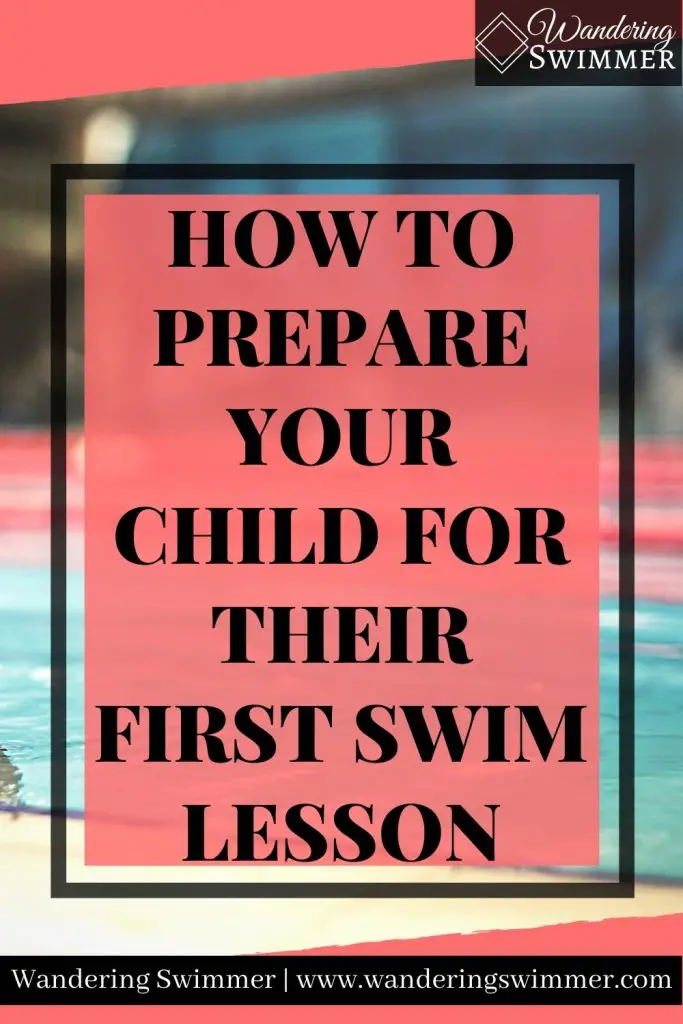First swim lessons can be exciting and scary for kids and parents alike. The good news though is that you can help your child prepare for their first swim lesson.
More Content for You: Make Learning to Swim Your New Year’s Resolution
This will help them overcome any anxiety or concerns. And hopefully, make lessons easier on everyone involved 🙂
Disclosure: This post may contain affiliate links, meaning we earn a small commission at no cost to you if you purchase something through one of our links. As an Amazon Associate, we earn from qualifying purchases. Please check out our disclosure page for more information.

Before Lessons
Get them Comfortable in the Water
A child that’s comfortable in the water tends to have a better swim lesson. Most of the anxiety comes from the fear of water and being alone without a parent next to them.
If you can help your child get comfortable in the water, they might have an easier first lesson.
During bath time, let them splash around and kick their legs. This lets them feel the water around their body until it feels comfortable. Splash your hands in the water with them and try to keep excited during this playtime.
Remember, you’re not looking for perfect technique. This is just to get them familiar and comfortable with the water around them.
Face in the Water
One of the biggest challenges kids have to overcome is putting their face in the water. For some, this is terrifying. Especially if they’ve never done it before.
Don’t force the issue if your child refuses to put their face in the water. Instead, try trickling some water on their hair so that some of it wets their face. This can help them feel the sensation of water on their face without actually putting their face in the water.
Again, stay positive and encouraging. Don’t panic if your child does put their face in the water and they come up sputtering. Instead, give them tons of praise and good feedback. This typically encourages them to try it again.
Most of all, stay calm and don’t get agitated. Your child will likely pick up on these non-verbal cues and start to get scared or frustrated, too.
Blow Bubbles
If your child doesn’t mind putting their face in the water, see if you can encourage them to blow bubbles.
It usually takes younger kids a while to understand this concept, but you can still try it! Show them how you can blow bubbles and see if they can copy you.
Some kids get a kick out of this while others could care less. Be patient and overly encouraging. If they end up blowing some bubbles, heap on the praise 🙂
Take them to the Pool before Lessons
One great way to prepare your child for swim lessons is to take them to a pool.
If your child has never been to the pool before, it’s a good idea to get them familiar with one prior to lessons. This is a great way to spend time together. But it’s also exposing them to a large body of water outside of their bathtub.
It also helps if other kids are there that they can watch. Seeing other kids in the pool and having fun can be an encouragement for them to get in the water.
This will also help them adjust to wearing a swimsuit if they’ve never worn one before.
Related articles:
Encourage your child while they’re in the water with you. Let them see how excited you are to be in the water and try to find their comfort level. Some kids will want to paddle about on their own. And others will hold onto you.
Keep patient and figure out their limits.
You can also use this time to discuss water safety and rules with your child. Let them know that they can’t get into the water without an adult. And that they shouldn’t run around.
Discuss Swim Lessons with Them
Don’t spring swim lessons onto your child without warning. In that, don’t just show up at the pool and wiggle them into a swimsuit without once telling them why.
Instead, let them know that they’ll be taking lessons soon. And tell them why it’s important that they take lessons.
Will they have questions? Absolutely!! You should be prepared for some questions leading up to their first swim lesson. Answer them as best as you can. And if there’s something you don’t know, ask the school or instructor.
More Content for You: Can I Get Swimmer’s Ear from Swim Lessons?
You should also let your child help you pick out their swimsuit. This helps them feel involved and a bit more in control of the situation. Make sure that their suit fits before their first swim lesson!
Lastly, stay positive in these discussions. Be sure to let them know that lessons will be fun and how great they can be.
Swim Lesson Journal
Writing out goals or getting your child excited about starting swim lessons is a great way to prepare them for lessons. Before their first lesson, ask them what they want to learn or try and write it down for them.
Doing this can help your child focus on something they want to learn and can help make the experience less scary for them. The goal can be as simple or silly as they like.
Related article: 6 Reasons to Use a Journal for Swim Lessons
While your child might not hit every goal they set for themselves, it can still help them to see how close they came to it. And as they get older or at the end of lessons, they can look back to see how far they’ve come.
We recommend H2O Society’s journal for helping set goals and tracking milestones. It’s a thorough journal that helps you document the start of swim lessons all the way through the very last lesson. There’s also two pages to detail what your child likes and dislikes about practice so you can help them overcome any obstacles.
You can find a full list of pages provided and more information on the listing. And you can also browse more swimming related items at their store 🙂
First Day of Swim Lessons
Arrive Early for Lessons
On the first day of lessons, it’s best to arrive early. Reminder your child that morning that they’ll be going to lessons that day.
Our advice is to have them changed into their swimsuit before leaving. This way, if you’re running late, you’re not spending extra time trying to get your child changed. It might also be easier for your child to change at home as it’s already familiar to them.
Related article: What Do You Need to Pack for Swim Lessons?
When you arrive early, it gives you and your child a moment to watch the lesson before them. Seeing other kids splashing around and having fun might help prepare your child for their own swim lesson.
Make sure to point out the various dive toys that the other kids get to play with. And show how much fun they’re having. Build up the hype so your child is excited and willing to give lessons a try.
Arriving early can also allow you to see how the instructors act with their students. And hopefully, give you some peace of mind!
At Lesson Time
Be supportive when it’s time for your child to head out for their lesson. But also expect some tears if your child is a little anxious already.
Some schools do allow parents to walk their children out onto the deck for their first lesson or two. See if you can do this for your child if they’re struggling. Try to sit close to where their class is so they can see you easier, too.
More Content for You: Your Complete Guide to Swim Lessons for Adults
And if need be, point to where you’ll be sitting and let them know that you’ll be watching.
Be Patient
First swim lessons (and sometimes several after) can be challenging for kids and parents alike. There can be screaming and crying involved from at least one child. And if it’s your child, that’s okay!
The instructors are used to this and they’ll do their best to help calm them down.
One thing we would encourage parents to remember is that it’s okay to let your child cry at lessons. Most times it’s just the initial shock of being away from their parents. But once they start the lesson, the tears tend to go away.
I’ve coaxed more than my fair share of crying kiddos asking for mommy into the water. And ended the lesson with smiles and excitement.
If you come racing out at the first sign of tears, your child learns that they can get out of lessons when they’re upset. And it sets the tone for the rest of their lessons.
Instead, be patient with your child, the instructor, and yourself.
Stay Positive and Encouraging
After your child’s first lesson (and every one thereafter), be sure to heap on the praise and encouragement. Tell your child how excited and proud you were at what they learned that day. No matter how small it might be.
The more you show interest in their swim lessons, the more excited they’ll be to go back.
What if your child had a bad lesson?
That’s okay!! It happens. Not every swim lesson will be a great one. And every child learns at their own pace.
If this happens, keep encouraging them. Try to get them comfortable with whatever they struggled with at a local pool. Or even in the bathtub if you can.
Not every child will be an Olympian the first time in the water. Even Katie Ledecky and Michael Phelps had to start somewhere!
As always, to happy swimming!
-Chevron
Bonus Content:
When Should My Child Start Swim Lessons?: Swim lessons are a necessity for anyone. But what is the ‘right age’ for your child to start swim lessons? And what should parents know about them?
How to Choose the Best Swim School: What to look for in a swim school varies based on your needs. Here are 10 items to consider when picking the best swim school.

Want to Improve at the Pool?
Join swimmers and swim parents to receive my free newsletter and receive a free Swimming Glossary e-book as a thanks!
Every month you’ll receive tips and coaching to help you find success at the pool.
